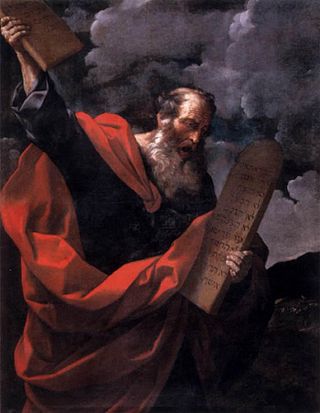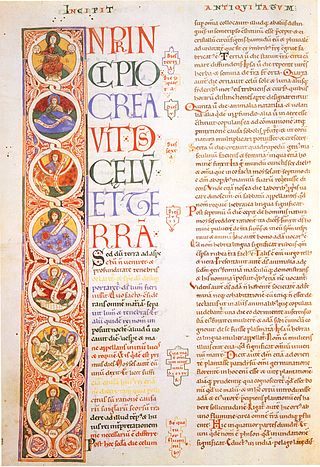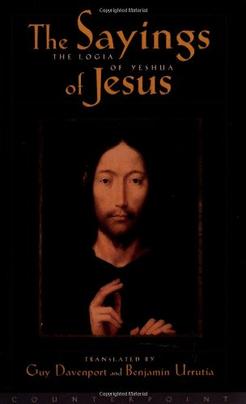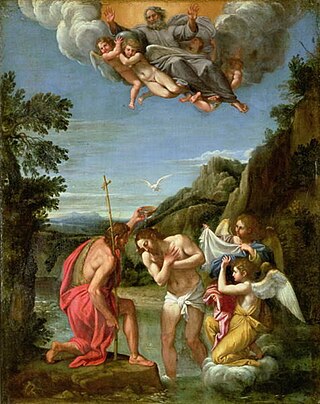Related Research Articles

Moses is considered the most important prophet in Judaism and one of the most important prophets in Christianity, Islam, the Druze Faith, the Baháʼí Faith, Samaritanism, and Rastafariansim. According to both the Bible and the Quran, Moses was the leader of the Israelites and lawgiver to whom the prophetic authorship of the Torah is attributed.
The Book of Ether is one of the books of the Book of Mormon. It describes the Jaredites, descendants of Jared and his companions, who were led by God to the Americas shortly after the confusion of tongues and the destruction of the Tower of Babel. Ether consists of fifteen chapters.

The Israelites were a group of Semitic-speaking tribes in the ancient Near East who, during the Iron Age, inhabited a part of Canaan.

The Book of Mormon, a work of scripture of the Latter Day Saint movement, describes itself as having a portion originally written in reformed Egyptian characters on plates of metal or "ore" by prophets living in the Western Hemisphere from perhaps as early as the 6th century BC until as late as the 5th century AD. Joseph Smith, the movement's founder, published the Book of Mormon in 1830 as a translation of these golden plates. Smith said that after he finished the translation, he returned the golden plates to the angel Moroni.
Yeshua was a common alternative form of the name Yehoshua in later books of the Hebrew Bible and among Jews of the Second Temple period. The name corresponds to the Greek spelling Iesous (Ἰησοῦς), from which, through the Latin IESVS/Iesus, comes the English spelling Jesus.

According to most adherents of the Latter Day Saint movement, the Book of Mormon is a 19th-century translation of a record of ancient inhabitants of the American continent, which was written in a script which the book refers to as "reformed Egyptian". This claim, as well as all claims to historical authenticity of the Book of Mormon, are rejected by non-Latter Day Saint historians and scientists. Linguistically based assertions are frequently cited and discussed in the context of the subject of the Book of Mormon, both in favor of and against the book's claimed origins.

According to the Book of Mormon, Lehi was a prophet who lived in Jerusalem during the reign of King Zedekiah. In First Nephi, Lehi is rejected for preaching repentance and he leads his family, including Sariah, Laman, Lemuel, Sam, and Nephi, into the wilderness. He sends his sons back to recover the plates of brass and once more for the family of Ishmael. As they travel, Lehi has a vision of the tree of life in which most of his family, excepting Laman and Lemuel, accepts God. He also prophesies Christ's coming 600 years in the future.

According to the Book of Mormon, King Benjamin, son of King Mosiah the first, was the second Nephite king to rule over Zarahemla. An account of his life and teachings are recorded in both the Words of Mormon and the Book of Mosiah. He was considered a king and a prophet, and was the spiritual and governmental leader of his people. He is believed to have been born roughly 190 BC.

Hugh Winder Nibley was an American scholar and member of the Church of Jesus Christ of Latter-day Saints who was a professor at Brigham Young University (BYU) for nearly 50 years. He was a prolific author, and wrote apologetic works supporting the archaeological, linguistic, and historical claims of Joseph Smith. He was a member of the LDS Church, and wrote and lectured on LDS scripture and doctrinal topics, publishing many articles in the LDS Church magazines.

Guy Mattison Davenport was an American writer, translator, illustrator, painter, intellectual, and teacher.

Antiquities of the Jews is a 20-volume historiographical work, written in Greek, by historian Josephus in the 13th year of the reign of Roman emperor Domitian, which was 94 CE. The book contains an account of the history of the Jewish people for Josephus' gentile patrons. In the first ten volumes, Josephus follows the events of the Hebrew Bible beginning with the creation of Adam and Eve.

The Logia of Yeshua, by Guy Davenport and Benjamin Urrutia, published by Counterpoint Press, is a compendium of canonical and extracanonical sayings of Jesus that are considered authentic by the authors. The book won critical praise for its scholarship and poetic language. "Throughout, The Logia of Yeshua freshens familiar New Testament injunctions, encouraging us to think anew about their meanings." "Davenport and Urrutia must be applauded for their desire to awaken the reader by offering these new, bare translations of Jesus' sayings."

The criterion of embarrassment is a type of historical analysis in which a historical account is deemed likely to be true under the inference that the author would have no reason to invent a historical account which might embarrass them. Certain Biblical scholars have used this as a metric for assessing whether the New Testament's accounts of Jesus' actions and words are historically probable.

Avraham Gileadi is a Dutch-born American scholar and professor specializing in the Hebrew language and analysis of Book of Isaiah. A longtime professor at Brigham Young University, he was one of the "September Six" of prominent scholars excommunicated by the Church of Jesus Christ of Latter-day Saints in 1993, but several years later Gileadi was formally readmitted into the church and insists that his excommunication was recognized by church leadership as "a mistake".

The Ten Lost Tribes were the ten of the Twelve Tribes of Israel that were said to have been exiled from the Kingdom of Israel after its conquest by the Neo-Assyrian Empire c. 722 BCE. These are the tribes of Reuben, Simeon, Dan, Naphtali, Gad, Asher, Issachar, Zebulun, Manasseh, and Ephraim---all but Judah, Benjamin, and some members of the priestly Tribe of Levi, which did not have its own territory. However, since the tribe of Simeon lived well within the territory of Judah, it is not clear why this tribe was never included in this list. Also, the tribes of Asher and Reuben were never mentioned as participating in anything after the conquest, living in either Phoenician (Asher) or Moabite (Reuben) controlled territory. By the middle 9th century BCE the territory of Gad was also (re)taken by the Moabites, so the Assyrians could at most have removed the other six tribes. Thus, the "10 tribes" appears to be a misnomer, meaning all of the Israelites that were living outside the Kingdom of Judah. The Jewish historian Josephus wrote that "there are but two tribes in Asia and Europe subject to the Romans, while the ten tribes are beyond Euphrates till now, and are an immense multitude, and not to be estimated by numbers".

According to the Book of Mormon, Mosiah I was a Nephite prophet who led the Nephites from the land of Nephi to the land of Zarahemla and was later appointed king. He was the father of King Benjamin and the first of two individuals in the Book of Mormon with the name Mosiah. His grandson, Mosiah II was Benjamin's son and was king of the Nephite nation from about 124 BC to 91 BC.
Jewish deicide is the notion that the Jews as a people are collectively responsible for the killing of Jesus, even through the successive generations following his death. A Biblical justification for the charge of Jewish deicide is derived from Matthew 27:24–25. Some rabbinical authorities, such as 12th-century scholar Maimonides and, more recently, ultranationalist Israeli rabbi, Zvi Yehuda Kook (1891–1982), have asserted that Jesus was indeed stoned and hanged after being sentenced to death in a rabbinical court.

Sacred Name Bibles are Bible translations that consistently use Hebraic forms of the God of Israel's personal name, instead of its English language translation, in both the Old and New Testaments. Some Bible versions, such as the Jerusalem Bible, employ the name Yahweh, a transliteration of the Hebrew tetragrammaton (YHWH), in the English text of the Old Testament, where traditional English versions have LORD.

The following outline is provided as an overview of and topical guide to the Book of Mormon:

The lineage of Alma the Younger is a set of minor figures from the Book of Mormon who descended from Alma the Younger. They are described as Nephite record-keepers, missionaries and prophets.
References
- 1 2 Benjamin Urrutia, "The Name Connection", New Era , June 1983, 39
- ↑ See Bruce Warren, "A Cautious Interpretation of a Mesoamerican Myth: Reflections Upon Olmec-Jaredite Roots," in the Newsletter and Proceedings of the Society for Early Historic Archaeology , Number 154, July 1983. Warren accepts Urrutia's connection between the Olmec and the Jaredite peoples, and more specifically the meaning of Shiblon as "Lion Cub." This he uses to make a connection between Shiblon and Ixbalanque, one of the Hero Twins of Maya Mythology. "The consonants ... of Shiblon are equivalent to the consonants of the first part of Ixbalanque ('ix' is pronounced 'ish')." The names are as close semantically as they are phonetically, as Ixbalanque means "Jaguar Cub."
- ↑ See Mythlore from 1978 to 1986, e.g.
- ↑ LDSF2, 1985, Parables, Ludlow, MA – ISBN 0-9614960-0-2
- ↑ LDSF3, 1988, Parables, Ludlow, MA – ISBN 0-9614960-1-0
- ↑ VegetarianFriends.net
- ↑ Benjamin Urrutia, "Pilgrimage," The Peaceable Table, October 2008.
- ↑ The Logia of Yeshua, logion 2 and note 2.
- ↑ Benjamin Urrutia, "Gems," The Peaceable Table, March 2009.
- ↑ Benjamin Urrutia, Review of Guided by the Faith of Christ, by Stephen R. Kaufman. The Peaceable Table, November 2008.
- ↑ In Dialogue: A Journal of Mormon Thought 8:3–4 (1973)
- ↑ Review by Benjamin Urrutia of The Real Forbidden Fruit by Jeff Popick. The Peaceable Table, March 2007.
- ↑ "Family Conflicts," Mythlore 41 (1985).
- ↑ "The Legendary Nimrod and the Historical Amenhotep III," Newsletter and Proceedings of the Society for Early Historic Archaeology, 155 (1983)
- ↑ "El or Yahweh?" American Anthropologist, December 1972. "About El, Asherah, Yahweh and Anath," American Anthropologist, August 1973.
- ↑ Man, the Journal of the Royal Anthropological Institute 8:3, September 1973
- ↑ Urrutia, "Psalm 51 and the Egyptian Opening of the Mouth Ceremony," in Sarah Israelit-Groll (editor), Scripta Hierosolymitana – Egyptological Studies – Publications of the Hebrew University of Jerusalem, Magnes Press, pages 222–223 (1982).
- ↑ "New Information about Mulek, Son of the King," by Robert Smith and Benjamin Urrutia, chapter 40 of Reexploring the Book of Mormon (1992), ISBN 0-87579-600-1
- ↑ Benjamin Urrutia, "Translation of the Spangler Nodule," Newsletter and Proceedings of the Society for Early Historic Archaeology, number 155 (1984).
- ↑ Benjamin Urrutia, "Lévi-Strauss and Mormonism," American Anthropologist, 76, June 1974.
- ↑ Review of Mother Warriors – The Peaceable Table, January 2009.
- ↑ Book Review of The Logia of Yeshua in The Washington Post , April 7, 1996
- ↑ Book Review by Robert Jonas of The Logia of Yeshua – Shambhala Sun, September 1996 – page 71
- ↑ See American Anthropologist, December 1972 and August 1973, articles by Raphael Patai.